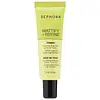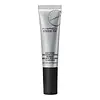What's inside
What's inside
 Key Ingredients
Key Ingredients

 Benefits
Benefits

 Concerns
Concerns

 Ingredients Side-by-side
Ingredients Side-by-side

Water
Skin ConditioningDimethicone
EmollientVinyl Dimethicone/Methicone Silsesquioxane Crosspolymer
Dimethicone/Vinyl Dimethicone Crosspolymer
Skin ConditioningCaprylic/Capric Triglyceride
MaskingButylene Glycol
HumectantCI 77220
Cosmetic ColorantPolyglyceryl-3 Disiloxane Dimethicone
Skin ConditioningPhenoxyethanol
PreservativeGlycerin
HumectantCarthamus Tinctorius Seed Oil
MaskingAmmonium Acryloyldimethyltaurate/Vp Copolymer
Tocopheryl Acetate
AntioxidantPolyglyceryl-3 Polydimethylsiloxyethyl Dimethicone
Skin ConditioningSilica
AbrasiveSodium Acrylate/Sodium Acryloyldimethyl Taurate Copolymer
Emulsion StabilisingCamellia Sinensis Leaf Extract
AntimicrobialHamamelis Virginiana Leaf Extract
Skin ConditioningIsohexadecane
EmollientSorbitan Trioleate
EmulsifyingPolysorbate 80
EmulsifyingSodium Chloride
MaskingSorbitan Oleate
EmulsifyingApium Graveolens Seed Extract
AntioxidantLinum Usitatissimum Seed Extract
PerfumingCitric Acid
BufferingTocopherol
AntioxidantWater, Dimethicone, Vinyl Dimethicone/Methicone Silsesquioxane Crosspolymer, Dimethicone/Vinyl Dimethicone Crosspolymer, Caprylic/Capric Triglyceride, Butylene Glycol, CI 77220, Polyglyceryl-3 Disiloxane Dimethicone, Phenoxyethanol, Glycerin, Carthamus Tinctorius Seed Oil, Ammonium Acryloyldimethyltaurate/Vp Copolymer, Tocopheryl Acetate, Polyglyceryl-3 Polydimethylsiloxyethyl Dimethicone, Silica, Sodium Acrylate/Sodium Acryloyldimethyl Taurate Copolymer, Camellia Sinensis Leaf Extract, Hamamelis Virginiana Leaf Extract, Isohexadecane, Sorbitan Trioleate, Polysorbate 80, Sodium Chloride, Sorbitan Oleate, Apium Graveolens Seed Extract, Linum Usitatissimum Seed Extract, Citric Acid, Tocopherol
Water
Skin ConditioningDimethicone
EmollientMethyl Trimethicone
Skin ConditioningVinyl Dimethicone/Methicone Silsesquioxane Crosspolymer
Dimethicone/Vinyl Dimethicone Crosspolymer
Skin ConditioningButylene Glycol
HumectantHamamelis Virginiana Water
AstringentCI 77220
Cosmetic ColorantIsononyl Isononanoate
EmollientAmmonium Acryloyldimethyltaurate/Vp Copolymer
Salix Nigra Bark Extract
Skin ProtectingLactobionic Acid
BufferingTocopheryl Acetate
AntioxidantSodium Hyaluronate
HumectantLaminaria Saccharina Extract
Skin ProtectingEcklonia Cava Extract
Skin ConditioningButyl Avocadate
Skin ConditioningPolyglyceryl-3 Disiloxane Dimethicone
Skin ConditioningPolyglyceryl-3 Polydimethylsiloxyethyl Dimethicone
Skin ConditioningEthylhexylglycerin
Skin ConditioningIsohexadecane
EmollientHydrolyzed Soy Protein
HumectantAcetyl Glucosamine
Skin ConditioningZinc PCA
HumectantPropanediol
SolventSodium Chloride
MaskingAcrylamide/Sodium Acryloyldimethyltaurate Copolymer
Emulsion StabilisingSynthetic Fluorphlogopite
Hydroxyapatite
AbrasiveSilica
AbrasiveNylon-12
Polysorbate 80
EmulsifyingLauryl Methacrylate/Glycol Dimethacrylate Crosspolymer
Coconut Acid
CleansingSalicylic Acid
MaskingParfum
MaskingBHT
AntioxidantTocopherol
AntioxidantPhenoxyethanol
PreservativeBenzoic Acid
MaskingZinc Oxide
Cosmetic ColorantWater, Dimethicone, Methyl Trimethicone, Vinyl Dimethicone/Methicone Silsesquioxane Crosspolymer, Dimethicone/Vinyl Dimethicone Crosspolymer, Butylene Glycol, Hamamelis Virginiana Water, CI 77220, Isononyl Isononanoate, Ammonium Acryloyldimethyltaurate/Vp Copolymer, Salix Nigra Bark Extract, Lactobionic Acid, Tocopheryl Acetate, Sodium Hyaluronate, Laminaria Saccharina Extract, Ecklonia Cava Extract, Butyl Avocadate, Polyglyceryl-3 Disiloxane Dimethicone, Polyglyceryl-3 Polydimethylsiloxyethyl Dimethicone, Ethylhexylglycerin, Isohexadecane, Hydrolyzed Soy Protein, Acetyl Glucosamine, Zinc PCA, Propanediol, Sodium Chloride, Acrylamide/Sodium Acryloyldimethyltaurate Copolymer, Synthetic Fluorphlogopite, Hydroxyapatite, Silica, Nylon-12, Polysorbate 80, Lauryl Methacrylate/Glycol Dimethacrylate Crosspolymer, Coconut Acid, Salicylic Acid, Parfum, BHT, Tocopherol, Phenoxyethanol, Benzoic Acid, Zinc Oxide
 Reviews
Reviews

Ingredients Explained
These ingredients are found in both products.
Ingredients higher up in an ingredient list are typically present in a larger amount.
Ammonium Acryloyldimethyltaurate/Vp Copolymer (let's call it AAVC for short) is a synthetically created polymer. It's used as a film-forming agent and used to thicken the consistency of products.
AAVC is able to increase the consistency and viscosity of products due to its large molecule size. It also prevents ingredients from separating.
Butylene Glycol (or BG) is used within cosmetic products for a few different reasons:
Overall, Butylene Glycol is a safe and well-rounded ingredient that works well with other ingredients.
Though this ingredient works well with most skin types, some people with sensitive skin may experience a reaction such as allergic rashes, closed comedones, or itchiness.
Learn more about Butylene GlycolWe don't have a description for CI 77220 yet.
Dimethicone is a type of synthetic silicone created from natural materials such as quartz.
What it does:
Dimethicone comes in different viscosities:
Depending on the viscosity, dimethicone has different properties.
Ingredients lists don't always show which type is used, so we recommend reaching out to the brand if you have questions about the viscosity.
This ingredient is unlikely to cause irritation because it does not get absorbed into skin. However, people with silicone allergies should be careful about using this ingredient.
Note: Dimethicone may contribute to pilling. This is because it is not oil or water soluble, so pilling may occur when layered with products. When mixed with heavy oils in a formula, the outcome is also quite greasy.
Learn more about DimethiconeThis ingredient is a silicone used to improve the texture of products and absorb oil. It does not get absorbed into the skin.
Like other silicones, Dimethicone/Vinyl Dimethicone Crosspolymer helps condition the skin by creating a barrier. In this sense, it can act as an emollient and trap moisture in.
This ingredient is a type of elastomer.
Learn more about Dimethicone/Vinyl Dimethicone CrosspolymerIsohexadecane is added to enhance texture, emulsify, and to help cleanse. It is an isoparrafin. It is a component of petrolatum.
Due to its large size, Isohexadecane is not absorbed by the skin. Instead, it sits on top and acts as an emollient. Emollients help keep your skin soft and smooth by trapping moisture within.
Isohexadecane is often used in products designed to help oily skin. It is lightweight and non-greasy while helping to moisturize. When mixed with silicones, it gives a product a silky feel.
Learn more about IsohexadecanePhenoxyethanol is a preservative that has germicide, antimicrobial, and aromatic properties. Studies show that phenoxyethanol can prevent microbial growth. By itself, it has a scent that is similar to that of a rose.
It's often used in formulations along with Caprylyl Glycol to preserve the shelf life of products.
Polyglyceryl-3 Disiloxane Dimethicone is a type of silicone.
Polyglyceryl-3 Polydimethylsiloxyethyl Dimethicone is a type of silicone.
Polysorbate 80 is a surfactant and emulsifier. It is used to keep ingredients together, and prevent oils and waters from separating.
It is made from polyethoxylated sorbitan and oleic acid. This ingredient can be found in cosmetics, foods, and medicine. It is water-soluble.
Polysorbate 80 may not be fungal acne safe.
Learn more about Polysorbate 80Silica, also known as silicon dioxide, is a naturally occurring mineral. It is used as a fine, spherical, and porous powder in cosmetics.
Though it has exfoliant properties, the function of silica varies depending on the product.
The unique structure of silica enhances the spreadability and adds smoothness, making it a great texture enhancer.
It is also used as an active carrier, emulsifier, and mattifier due to its ability to absorb excess oil.
In some products, tiny microneedles called spicules are made from silica or hydrolyzed sponge. When you rub them in, they lightly polish away dead skin layers and enhance the penetration of active ingredients.
Learn more about SilicaChances are, you eat sodium chloride every day. Sodium Chloride is also known as table salt.
This ingredient has many purposes in skincare: thickener, emulsifier, and exfoliator.
You'll most likely find this ingredient in cleansers where it is used to create a gel-like texture. As an emulsifier, it also prevents ingredients from separating.
There is much debate on whether this ingredient is comedogenic. The short answer - comedogenic ratings don't tell the whole story. Learn more about comegodenic ratings here.
The concensus about this ingredient causing acne seems to be divided. Research is needed to understand if this ingredient does cause acne.
Scrubs may use salt as the primary exfoliating ingredient.
Learn more about Sodium ChlorideTocopherol (also known as Vitamin E) is a common antioxidant used to help protect the skin from free-radicals and strengthen the skin barrier. It's also fat soluble - this means our skin is great at absorbing it.
Vitamin E also helps keep your natural skin lipids healthy. Your lipid skin barrier naturally consists of lipids, ceramides, and fatty acids. Vitamin E offers extra protection for your skin’s lipid barrier, keeping your skin healthy and nourished.
Another benefit is a bit of UV protection. Vitamin E helps reduce the damage caused by UVB rays. (It should not replace your sunscreen). Combining it with Vitamin C can decrease sunburned cells and hyperpigmentation after UV exposure.
You might have noticed Vitamin E + C often paired together. This is because it is great at stabilizing Vitamin C. Using the two together helps increase the effectiveness of both ingredients.
There are often claims that Vitamin E can reduce/prevent scarring, but these claims haven't been confirmed by scientific research.
Learn more about TocopherolTocopheryl Acetate is AKA Vitamin E. It is an antioxidant and protects your skin from free radicals. Free radicals damage the skin by breaking down collagen.
One study found using Tocopheryl Acetate with Vitamin C decreased the number of sunburned cells.
Tocopheryl Acetate is commonly found in both skincare and dietary supplements.
Learn more about Tocopheryl AcetateThis ingredient is used in makeup and skincare to thicken formulas, reduce shine, and give skin a silky-smooth feel.
It’s a white silicone powder that sits in fine lines and pores to blur their appearance though its effectiveness depends on the particle size.
You'll typically find this ingredient in amounts between 0.1-20%.
Learn more about Vinyl Dimethicone/Methicone Silsesquioxane CrosspolymerWater. It's the most common cosmetic ingredient of all. You'll usually see it at the top of ingredient lists, meaning that it makes up the largest part of the product.
So why is it so popular? Water most often acts as a solvent - this means that it helps dissolve other ingredients into the formulation.
You'll also recognize water as that liquid we all need to stay alive. If you see this, drink a glass of water. Stay hydrated!
Learn more about Water